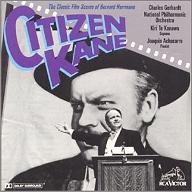 |
Citizen KaneBernard Herrmann |
|---|
 |
Citizen KaneBernard Herrmann |
|---|
|
Original music by Bernard Herrmann Composed for Citizen Kane, 1940 National Philharmonic Orchestra Charles Gerhardt, prod., June 1974 14 Tracks, Total Time 52:05 |
Contains 13:40 in four cues from Citizen Kane, conducted by Gerhardt. Also includes music from White Witch Dr., Hangover Square, On Dangerous Ground and Beneath the 12-Mile Reef. |
|
Few composers have the good fortune to land as their first assignment a film destined to achieve recognition as one of the masterpieces of world cinema. Bernard Herrmann was only 30 when he wrote the score for Citizen Kane, Orson Welles five years younger. He worked under what some of his colleagues must have regarded as near-Utopian conditions: "I was given 12 weeks to do my job. I worked on the film reel by reel, as it was being shot and cut. In this way I had a sense of the picture being built and of my own music being part of that building. Many of the sequences were actually tailored to match the music." Surely in no other film is music so integral a part of the fabric nor does it grow so naturally out of its inner rhythm and texture.
In Citizen Kane a reporter, trying to discover the meaning of Kane's dying word, "Rosebud," meets and talks with several of those most intimately involved with him. In a rapid series of flashbacks the audience learns something about the magnate's childhood, his character, rise to power and ultimate downfall. So there are two central ideas--Rosebud, representing for Kane the unspoiled world of his boyhood, and its antithesis, Kane's ambition, his all-consuming lust for power, vain and profitless at the last. Herrmann decided to evolve musical equivalents, or leitmotifs, for these twin concepts, and both are first heard in the opening sequence, which takes us into the eerie nocturnal world of Kane's pleasure-palace, Xanadu.
As the vague outline of the main tower becomes distinguishable, low brass and woodwinds sound the Kane theme. In a series of slow dissovles we are shown some of the fabulous contents of Xanadu, and the shimmering tones of the vibraphone tell us that Rosebud must be buried somewhere among them. The music continues in the manner of a subdued requiem for the dying Kane and then dissolves (via an ostinato-like transformation of the Kane motif) into the scene showing the boy Kane playing with his sled in the snow, Wellesian symbol of a lost innocence. Here the music is based on the Rosebud motif, which expands lyrically and happpily in the strings.
The Theme and Variations follows the breakup of Kane's first marriage in terms of the couple's progressively deteriorating relationship over the breakfast table. The whole sequence lasts only a couple of minutes and comprises a number of very brief scenes ranging from warmth and affection in the first to stony silnece and indifference in the last. Herrmann accompanies each scene by a mini-variation on a slow waltz theme, the variations becoming increasingly dissonant and less waltzlike as the atmosphere between the two becomes increasingly chilly.
Citizen Kane is unorthodox in most respects, and the musical handling of Susan Alexander Kane's disastrous debut as an opera singer posed a very special problem. Herrmann had somehow to find a fragment of grand opera that would convincingly demonstrate that while Susan possessed a voice of a kind, it was not that of a great opera singer. In addition the music had to reflect on its own terms both Susan's hysterical awareness of her own inadequacy, her anguish, and the general pandemonium raging around her. Herrmann realized that no excerpt from the standard repertoire could satisfactorily fulfill all these requirements.
His solution gives us one of film music's most unusual and memorable excerpts: he composed a recitative and aria for the final scene of a fictitious opera called Salammbo. For the film Herrmann engaged a ligh lyric soprano, her best efforts proving so unavailing against the power of the orchestra as to give the impression that she was floundering in quicksand. This magically solved the problem within the context of the film, but the aria has since been performed in public as it should have sounded--for this recording by Kiri Te Kanawa--had Susan Alexander been the singer her husband tried to pretend she was.
In the finale the reporter and his colleages prepare to leave Xanadu, admitting their quest to find the meaning of "Rosebud" was in vain. Somber brass chords, like those of the prologue, lead in with the Kane theme. The camera reaches the end of a long tracking shot over the vast accumulation of Kane's possessions; a workman feeding a furnace, and then the full orchestra hurls the Rosebud theme with all its might at the audience. The Kane theme, in the guise of a brass chorale, brings the drama to a shattering fortissimo conclusion.
--CHRISTOPHER PALMER, from the liner notes
Classic Film Scores of Bernard Herrmann.
A selection of Citizen Kane related music.
|
Find Citizen Kane on eBay.com
A selection of Citizen Kane in books.
|
|
home: The Film Noir 'net |
back to: NOIR MUSIC |
|
Any comments, additions or suggestions
should be addressed to: The Film Noir 'net / Eric B. Olsen / ericbolsen@juno.com |
Other Web Sites:
History of Horror Hard Bop Homepage The War Film Web Author Eric B. Olsen |